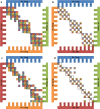Preoperative classification assessment reliability and influence on the length of intertrochanteric fracture operations
- PMID: 23254857
- PMCID: PMC3609981
- DOI: 10.1007/s00264-012-1748-6
Preoperative classification assessment reliability and influence on the length of intertrochanteric fracture operations
Abstract
Purpose: The accuracy of intertrochanteric fracture classification is important; indeed, the patient outcomes are dependent on their classification. The aim of this study was to use the AO classification system to evaluate the variation in classification between X-ray and computed tomography (CT)/3D CT images. Then, differences in the length of surgery were evaluated based on two examinations.
Methods: Intertrochanteric fractures were reviewed and surgeons were interviewed. The rates of correct discrimination and misclassification (overestimates and underestimates) probabilities were determined. The impact of misclassification on length of surgery was also evaluated.
Results: In total, 370 patents and four surgeons were included in the study. All patients had X-ray images and 210 patients had CT/3D CT images. Of them, 214 and 156 patients were treated by intramedullary and extramedullary fixation systems, respectively. The mean length of surgery was 62.1 ± 17.7 min. The overall rate of correct discrimination was 83.8 % and in the classification of A1, A2 and A3 were 80.0, 85.7 and 82.4 %, respectively. The rate of misclassification showed no significant difference between stable and unstable fractures (21.3 vs 13.1 %, P = 0.173). The overall rates of overestimates and underestimates were significantly different (5 vs 11.25 %, P = 0.041). Subtracting the rate of overestimates from underestimates had a positive correlation with prolonged surgery and showed a significant difference with intramedullary fixation (P < 0.001).
Conclusions: Classification based on the AO system was good in terms of consistency. CT/3D CT examination was more reliable and more helpful for preoperative assessment, especially for performance of an intramedullary fixation.
Figures



Similar articles
-
Three-dimensional CT Improves the Reproducibility of Stability Evaluation for Intertrochanteric Fractures.Orthop Surg. 2018 Aug;10(3):212-217. doi: 10.1111/os.12396. Orthop Surg. 2018. PMID: 30152606 Free PMC article.
-
Effect of reduction quality on post-operative outcomes in 31-A2 intertrochanteric fractures following intramedullary fixation: a retrospective study based on computerised tomography findings.Int Orthop. 2019 Aug;43(8):1951-1959. doi: 10.1007/s00264-018-4098-1. Epub 2018 Aug 16. Int Orthop. 2019. PMID: 30116869 Free PMC article.
-
Unstable intertrochanteric femur fractures in geriatric patients treated with the DLT trochanteric nail.Injury. 2015 Jul;46 Suppl 2:S41-6. doi: 10.1016/j.injury.2015.05.031. Epub 2015 May 26. Injury. 2015. PMID: 26021665
-
Proximal femoral nailing is superior to hemiarthroplasty in AO/OTA A2 and A3 intertrochanteric femur fractures in the elderly: a systematic literature review and meta-analysis.Int Orthop. 2020 Apr;44(4):623-633. doi: 10.1007/s00264-019-04351-9. Epub 2019 Jun 14. Int Orthop. 2020. PMID: 31201487
-
Hip Replacement as Alternative to Intramedullary Nail in Elderly Patients with Unstable Intertrochanteric Fracture: A Systematic Review and Meta-Analysis.Orthop Surg. 2019 Oct;11(5):745-754. doi: 10.1111/os.12532. Orthop Surg. 2019. PMID: 31663280 Free PMC article.
Cited by
-
The Role of Preoperative Computed Tomography on the Quality of Reduction and Outcomes in Intertrochanteric Fracture: A Controlled Trial.Biomed Res Int. 2021 Feb 12;2021:8854292. doi: 10.1155/2021/8854292. eCollection 2021. Biomed Res Int. 2021. PMID: 33628822 Free PMC article.
-
Does Computed Tomography Improve Reproducibility in the Classification of Transtrochanteric Fractures?Rev Bras Ortop (Sao Paulo). 2019 Jul;54(4):361-367. doi: 10.1055/s-0039-1693045. Epub 2019 Aug 20. Rev Bras Ortop (Sao Paulo). 2019. PMID: 31435099 Free PMC article.
-
Characterization of patient population receiving bioactive glass bone graft substitute as intraoperative treatment for orthopaedic trauma fractures.J Orthop. 2024 Apr 15;55:129-133. doi: 10.1016/j.jor.2024.04.019. eCollection 2024 Sep. J Orthop. 2024. PMID: 38706585 Free PMC article.
-
Evaluation of the Inter and Intra-Observer Reliability of the AO Classification of Intertrochanteric Fractures and the Device Choice (DHS, PFNA, and DCS) of Fixations.Ethiop J Health Sci. 2020 Sep;30(5):755-760. doi: 10.4314/ejhs.v30i5.15. Ethiop J Health Sci. 2020. PMID: 33911837 Free PMC article.
-
Prospective randomised controlled trial of an intramedullary nail versus a sliding hip screw for intertrochanteric fractures of the femur.Int Orthop. 2014 Jan;38(1):155-61. doi: 10.1007/s00264-013-2196-7. Epub 2013 Dec 7. Int Orthop. 2014. PMID: 24318319 Free PMC article. Clinical Trial.
References
-
- Hornby R, Evans JG, Vardon V. Operative or conservative treatment for trochanteric fractures of the femur. A randomised epidemiological trial in elderly patients. J Bone Joint Surg Br. 1989;71:619–623. - PubMed
-
- Handoll HH, Parker MJ (2008) Conservative versus operative treatment for hip fractures in adults. Cochrane Database Syst Rev 3:CD000337. doi:10.1002/14651858.CD000337.pub2 - PubMed
-
- Anglen JO, Weinstein JN, American Board of Orthopaedic Surgery Research Committee Nail or plate fixation of intertrochanteric hip fractures: changing pattern of practice. A review of the American Board of Orthopaedic Surgery Database. J Bone Joint Surg Am. 2008;90:700–707. doi: 10.2106/JBJS.G.00517. - DOI - PubMed
Publication types
MeSH terms
LinkOut - more resources
Full Text Sources
Medical

